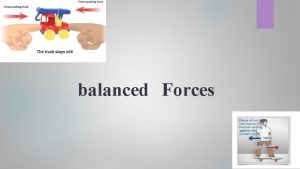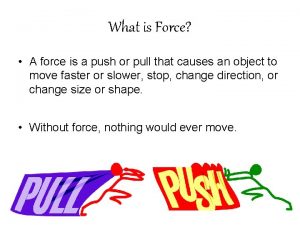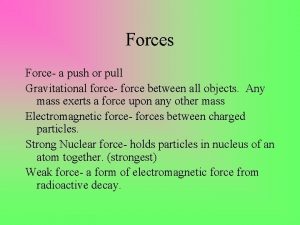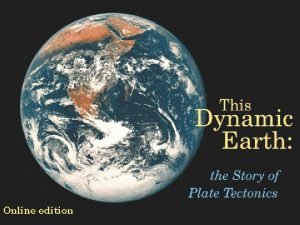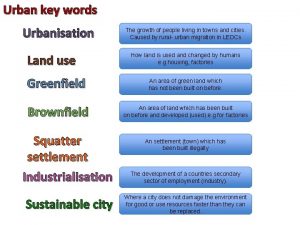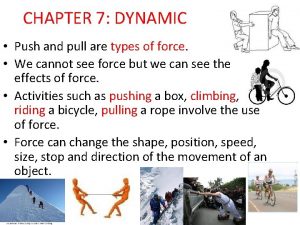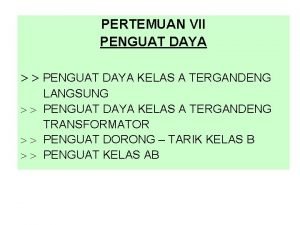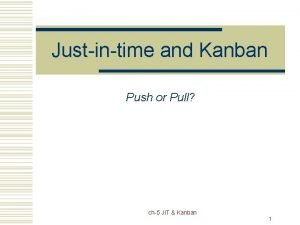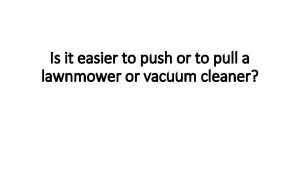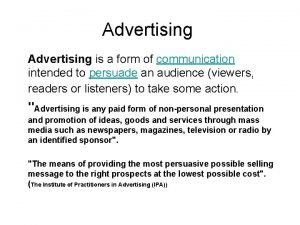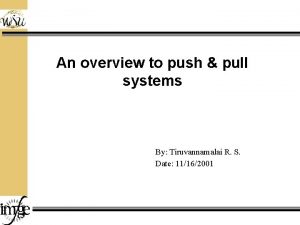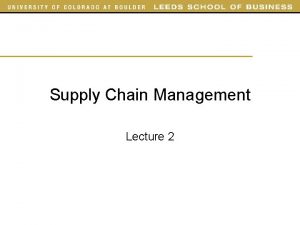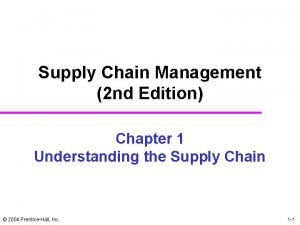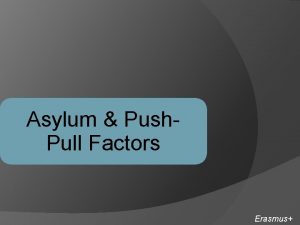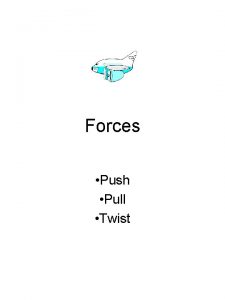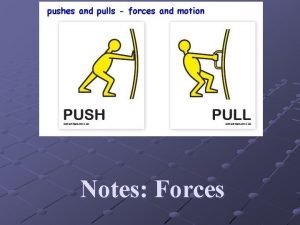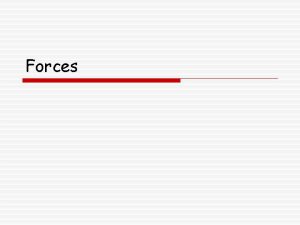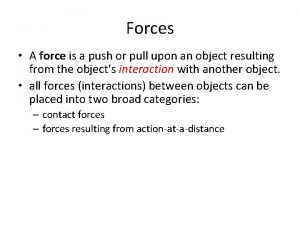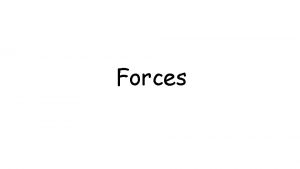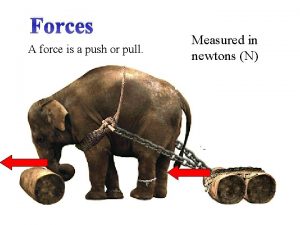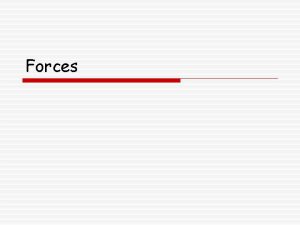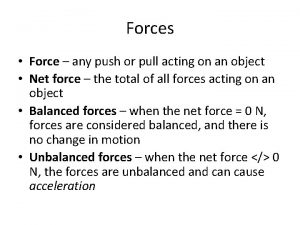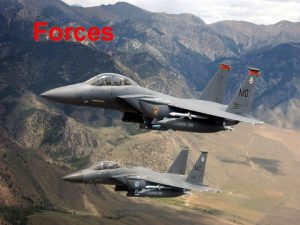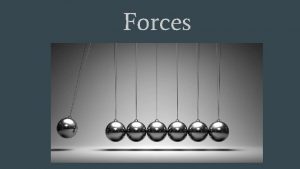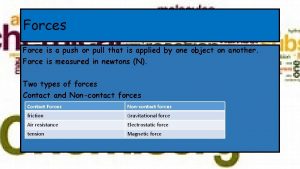Forces Force A push or a pull that































- Slides: 31

Forces

Force • A push or a pull that may cause an object’s motion to change! – Unit force is the Newton(N)! – It is a vector quantity. • Direction is important!!

• Do forces have to be “in contact” in order to have an affect on another object?

Balanced vs. Unbalanced Forces” • Balanced forces—forces • Unbalanced forces— that are equal in forces that are not magnitude, but equal in magnitude and opposite in direction!! opposite in direction! – Will not cause a change in the motion of the object!! – Will cause a change in the motion of the object!!

Are the forces Balanced or Unbalanced? Balanced Unbalanced

Balanced or Unbalanced: A. Balanced B. Unbalanced

Balanced or Unbalanced: A. Balanced B. Unbalanced

Net Force(Fnet) • Sum of all forces acting on an object. • If there is a net force acting on an object, the velocity of the object will change!!

Balanced or Unbalanced? Find the Net Force Unbalanced FNet = 30 N left

Balanced or Unbalanced? Find the Net Force Balanced FNet = 0 N

Balanced or Unbalanced? Find the Net Force Unbalanced FNet = 10 N Right

Balanced or Unbalanced? Find the Net Force Unbalanced FNet = 130 N down

Balanced or Unbalanced? Find the Net Force unbalanced FNet = 360 N right

Find the Net force in the diagram below: A) 120 N right B) 120 N left C) 20 N right D) 20 N left

Determine the Net Force: A) 10 N right B) 150 N right C) 160 N right D) 150 N left


Newton’s st 1 Law of Motion • also known as the “Law of Inertia”. – Inertia—tendency of an object to resist change in motion. • Explain? ? ? • What does inertia depend on? • 1 st Law--An object at rest stays at rest and an object in motion stays in motion, unless acted on by some unbalanced force!

More thoughts on Inertia: What gives an object inertia? ?

Inertia(cont): Mass gives an object inertia!! It is easier to change the motion of a small object than it is to change the motion of a larger object!! Does anything else affect inertia?

I must think about balancing my bike!!! Inertia(cont. ) Think about a bicycle!! Ever tried to balance on a bike while standing still? Was it easy? Was it impossible?

I must think about balancing my bike!!! Inertia(cont. ) When you ride your bike down the road, how many of you think to yourself, “I must balance my bike, I must balance my bike!!” What’s the difference? Click me #1 Click me #2

Newton’s 1 st Law of Motion(cont. ) • If you roll a ball across the floor, why does it eventually come to a stop. – Is there a force acting against it? – If so, what is it? • Friction—force that opposes motion. – Always acts in the direction opposite of motion. Anything slowing this Coke as it slides across the bar?

Newton’s nd 2 Law of Motion • called the “Law of Acceleration”. • Relates force, mass, and acceleration. • Force and acceleration directly related. • Mass and acceleration inversely related.

Newton’s 2 nd Law of Motion(cont. ) F=ma • Where: ØF = force in Newton’s(N) Øm = mass in kilograms(kg) Øa = acceleration in m/s 2

Ex. What force is required to accelerate a 1500 kg car by a rate of 1. 5 m/s/s? Given: m = 1500 kg a = 1. 5 m/s/s F=? F=ma F = 1500 kg(1. 5 m/s/s) F = 2250 N

Ex. A force of 290 N is applied to a 20 kg rock. At what rate will the rock accelerate? Given: m = 20 kg a=? F = 290 N F=ma a = 14. 5 m/s 2

Ex. A force of 140 N is applied to a mover’s dolly to accelerate a load of Cokes across the grocery store at 3 m/s 2. What is the mass of the load of Cokes? Given: F = 140 N a = 3 m/s 2 m=?

A force is applied to accelerate a 50 kg mass at a rate of 2. 5 m/s/s. What force is required? A. B. C. D. 20 N 25 N 120 N 125 N

A 250 N is applied to a 12 kg mass. At what rate will the object accelerate? A. 3000 m/s/s B. 240 m/s/s C. 20. 8 m/s/s D. . 05 m/s/s

Newton’s rd 3 Law • For every action, there is an equal but opposite reaction. Forces always occur in pairs!!

Which of the following scenarios does not represent Newton’s 3 rd Law? A. A rocket being launched into space. B. A book resting on a desk. C. A person paddling a canoe. D. A large force pushing on a small mass, causing it to accelerate.
 Balanced force definition
Balanced force definition Type of force applied
Type of force applied Gravitational force push or pull
Gravitational force push or pull Angel of pull
Angel of pull Tectonic plate boundaries map
Tectonic plate boundaries map Marketing objectives examples
Marketing objectives examples Push and pull factors of migration ppt
Push and pull factors of migration ppt Strategia push i pull
Strategia push i pull Carefully blended mix of promotion tools
Carefully blended mix of promotion tools Push pull osmotic pump
Push pull osmotic pump Influencing styles
Influencing styles Urban key house
Urban key house Landflucht push und pull faktoren
Landflucht push und pull faktoren Kanban push pull
Kanban push pull Demand pull inflation
Demand pull inflation Push and pull chapter 7
Push and pull chapter 7 Push pull class b power amplifier
Push pull class b power amplifier Push and pull scenarios
Push and pull scenarios Different types of unemployment
Different types of unemployment Push and pull factors of urbanisation
Push and pull factors of urbanisation Jit
Jit Push pull profile strategies marketing communications
Push pull profile strategies marketing communications Push und pull faktoren
Push und pull faktoren Push
Push Fly by wire
Fly by wire Rabostic model
Rabostic model Push pull
Push pull Push pull in supply chain
Push pull in supply chain Push pull view of supply chain
Push pull view of supply chain Chinese immigration push factors
Chinese immigration push factors Veille informationnelle outils
Veille informationnelle outils Gizmo
Gizmo
